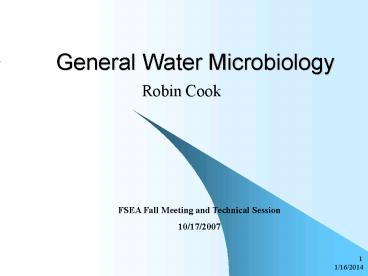General Water Microbiology PowerPoint PPT Presentation
1 / 16
Title: General Water Microbiology
1
General Water Microbiology
- Robin Cook
FSEA Fall Meeting and Technical Session 10/17/2007
2
Introduction
- Why we do this matters!
- How we do this matters!
- This is not just about meeting a regulatory
requirement.
3
Overview
- What are we looking for?
- Why are we looking?
4
Vocabulary
- Coliform Bacteria Gram (-),non-spore-forming,
facultative anaerobic, rod-shaped bacteria
capable of growth in the presence of bile salts
and that ferment lactose with production of gas,
acid and aldehyde within 48hrs at 35C. - OR Coliform Bacteria possessing the enzyme
?-galactosidase which cleaves ONPG resulting in a
release of a chromogen. - These definitions are operational rather than
taxonomic and therefore tied to a method as well.
5
Vocabulary cont.
- This definition includes Enterobacter aerogenes
which is NOT typically associated with the
intestine. - Depending on which defintion Serratia may or may
not be a coliform. Not all species will ferment
lactose.
6
Vocabulary Cont.
- Coliforms are members of the enteric bacteria
group also know as the Enterbacteriaceae family. - Fecal Coliforms are further defined as
thermotolerant coliforms capable of growth with
acid and gas formation at 44.5ºC.
7
Enterobacteriaceae Family
- Klebsiella, Enterobacter, Citrobacter, and
Escherichia are classified as coliforms. - Escherichia coli, Citrobacter freundii and
thermotolerant Klebsiella pneumoniae are
classified as fecal coliforms. - Non-coliforms include Proteus, Serratia
(depending), Yersinia, Shigella, and Salmonella.
These are excluded only because they do not
usually ferment lactose.
8
Other indicators
- Fecal Streptococcus Gram () bacteria which is a
normal inhabitant of the GI tract of warm-blooded
animals. - Only a few are pathogenic
- Persist well, but do not reproduce in the
environment. - Many isolates are not associated with humans.
9
Other indicators cont.
- Enterococcus subgroup of the Fecal
Streptococcus - can grow in 6.5 NaCl, at pH 9.6 and at both 10ºC
and 45ºC. - Used to check quality of recreational waters
10
Interesting Trivia
- Ratio of FCFS
- FCFS gt 4.0 human contamination
- FCFS lt 0.7 animal contamination
- Between suggests a mixed source
- Only valid in the 1st 24 hours, and technology
dependent
11
Concerns and Disease
- Klebsiella opportunistic pathogen. Can cause
infection in wounds, soft tissue and urinary
tract as well as pneumonia in immuno-compromised.
- Enterobacter, Citrobacter, and Serratia mostly
hospital-related infections - Serratia is particularly prevalent in maternity
wards - E. coli septiciema, UTI, neonatal meningitis,
gastroenteritis and hemorrhagic colitis. - Proteus UTI and contributes to the formation of
kidney stones due to pH change it causes.
12
Continued
- Yersinia septicemia, enterocolitis, Bubonic
Plague. - Shigella gastrointeritis
- Salmonella typhi Typhoid Fever
- Not in the family but grows in the same
conditions Vibrio cholerae which is what causes
cholera in untreated water.
13
Indicator Organisms
- Associated with the intestinal tract typically in
large numbers - Found in warm-blooded animals as well as humans
yet will die once excreted - Death-rate is similar to the pathogenic
Salmonella and Shigella - Both coliforms and pathogens react in a similar
manner during the water purification process.
14
Summary
- The presence of coliforms indicates a problem
- BUT, absence does not necessarily mean that there
is not a problem - Need as much information as possible to make a
good decision.
15
References
- Brock, Thomas D. et al. Biology of
Microorganisms 7th ed. Englewood Cliffs, NJ
Prentice Hall, 1994. - Cullimore, D. Roy. Practical Manual of
Groundwater Microbiology. Boca Raton, FL
Lewis, 1993. - Murry, Patrick R., et al. Medical Microbiology
2nd ed. St Loius, MO Mosby, 1994.
16
Any questions?

